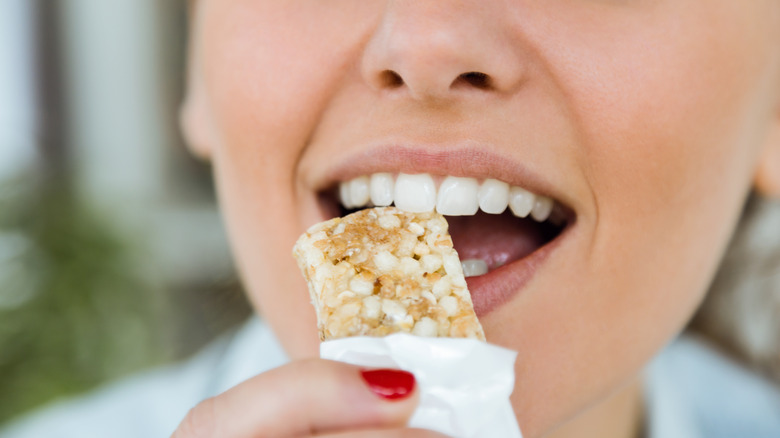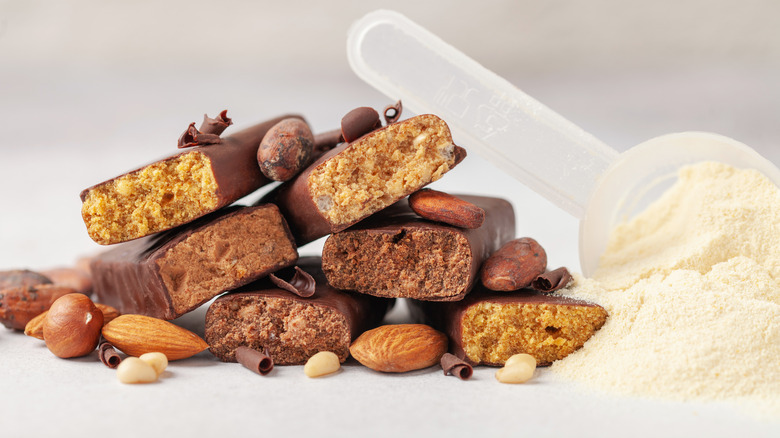The Truth About What's Inside Protein Bars
Protein bars are a convenient way to increase your protein intake. But knowing which ones to buy can be tricky, as most have long ingredient lists with hidden health culprits. One such culprit is the type sugar they may contain, according to Healthline. Particularly troublesome is an ingredient called high fructose corn syrup, which can increase your risk of obesity and diabetes if eaten in excess. High fructose corn syrup is made from corn and is similar to table sugar, but sweeter (via Cleveland Clinic). While protein bars often promise to keep us lean and trim, high fructose corn syrup can actually promote obesity, cause leaky gut, and increase hunger. For these reasons, it may be best to avoid the ingredient altogether.
Even if your bar doesn't contain high fructose corn syrup, it may contain sugar alcohols or artificial sweeteners instead. According to Healthline, sugar alcohols don't raise blood sugar as much as other carbohydrates and are low in calories. Other names for sugar alcohols include erythritol, sorbitol, and xylitol. While they're generally considered safe, eating too much at once can cause digestive upset like diarrhea, gas, and bloating.
Well, that explains the sweetening component of protein bars. But what about the protein itself?
Where do protein bars get their protein from?
There are three common types of protein found in protein bars: soy protein isolate, whey protein isolate, and hydrolyzed protein. Soy protein isolate comes from soybeans and contains roughly 90% protein, according to WebMD. In addition to being a tremendous source of protein, it can also help reduce cholesterol, help you lose weight, build muscle, and improve gut barrier functioning. While many fear that soy can increase the risk of hormonal cancers, it's actually been shown to help balance hormones and reduce the risk of breast cancer.
Whey protein isolate, on the other hand, is made from dairy milk and has many health benefits, including improving athletic performance, reducing symptoms of psoriasis, aiding in weight loss, and bolstering amino acid and nutrient intake (via Byrdie).
And if your protein bar contains hydrolyzed protein, you may have an easier time digesting and absorbing it. According to Shape, hydrolyzed proteins are pre-digested and thus more readily absorbed by our bodies. This can result in speedier recoveries from our hardest workouts.
So, now that we've checked our protein bar's nutrition label for sugar and protein, what about all these extra additives?
What some of the additives in your protein bar actually are
While a long list of additives on an ingredient list can seem unhealthy, some of them are considered safe and even health-promoting. Ingredients like palm oil, soy lecithin, and inulin may have positive impacts on our health. According to WebMD, palm oil is an excellent source of vitamin E, which can help prevent certain cancers and reduce the risk of heart disease and age-related macular degeneration. Soy lecithin, another popular additive, is generally safe in small amounts and may help lower cholesterol levels (via Healthline).
And what about other common ingredients like inulin? According to Medical News Today, inulin is a dietary fiber that can improve digestive health, prevent constipation, help with weight loss, maintain healthy blood sugar levels, and increase mineral absorption.
While unknown additives can seem intimidating, these are a few ingredients not to fear when scanning your protein bar's ingredient list.



